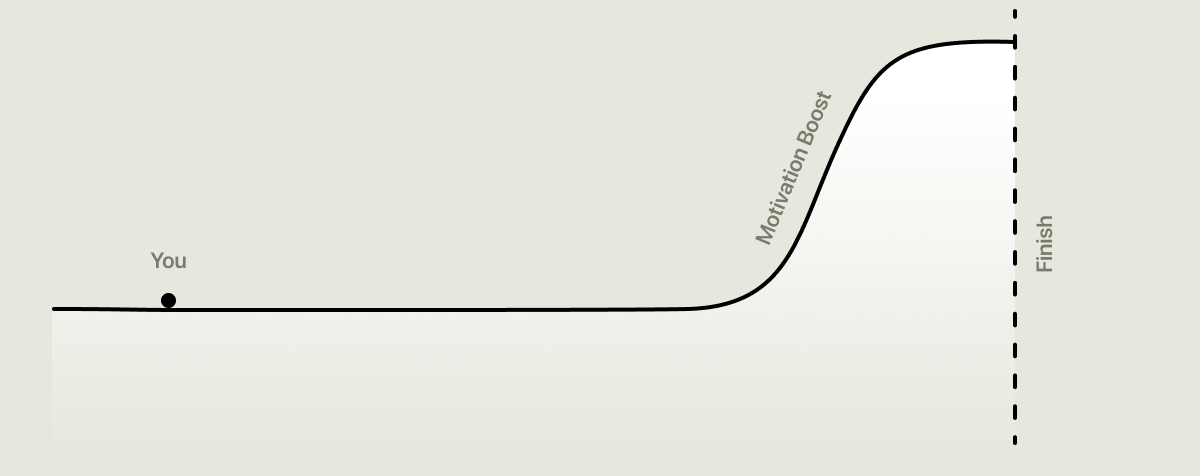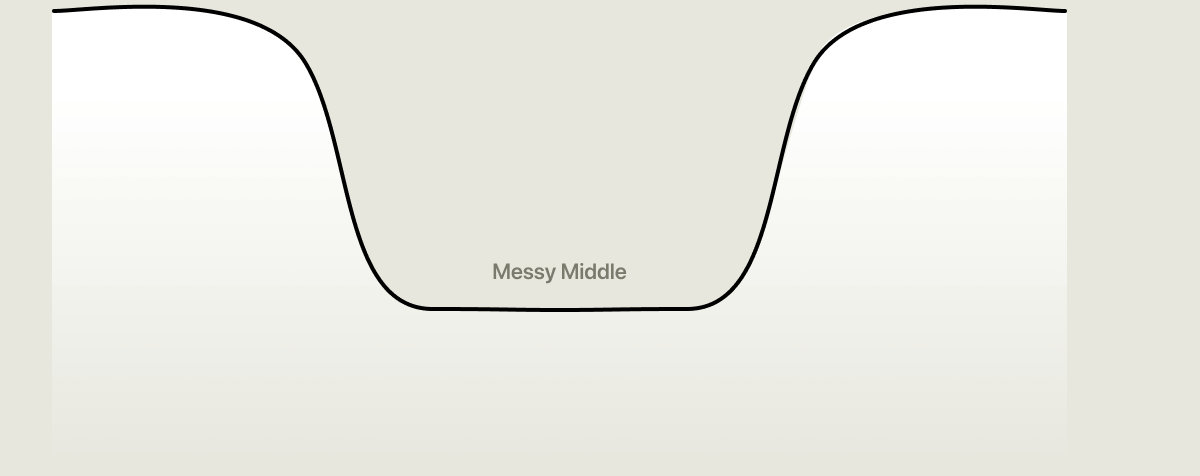Have you ever noticed that when you're near the end stage of a goal, you summon this untapped energy from within that drives you across the finish line?
This happens due to a phenomenon called the Goal Gradient Effect.
As you near completion of your goal and the reward seems within reach, your progress speeds up.
We can leverage this effect to our advantage to tackle some of our bold and never-ending goals.
In this blog post, I'll talk about the Goal Gradient Effect in detail, how it affects our workflow and how we can tweak our working style to use this fantastic phenomenon and achieve what we want.
But first, let's start by understanding:
The Goal Gradient effect
Unlike what we think and estimate, how we progress towards our goals is not linear.
We don't start, continue and end with the same energy and enthusiasm for any goals in our life.
This is how it works instead:

We start with a fresh boost of motivation and energy, which quickly dies down as we progress towards our goal.
And then, if we make it towards the end without giving up somewhere along the way, we magically summon a hidden energy that helps us get across the last patch and cross the finish line.
To visualise this better, imagine this scenario:
You're running a 5K marathon in your city.
The beginning is often easy. You start bursting with energy and a drive to finish the marathon.
Then, two kilometres into the run, your energy dies down. You start questioning whether this goal is even worth all the torture you're going through.
It feels tempting to give up and move to a more realistic goal.
And this is where most of us give up — the messy middle.
It's this long phase in our goals where we don't seem to progress despite all the effort we're putting in.
And even if we feel like making progress, the finish line seems far away and so out of reach that it requires a mountain of motivation to keep going.
But:
Say you manage to grind your way through the messy middle.
Despite all the resistance and negative thoughts in your head, you cross the messy middle and reach near the end of your goal.
You're just 500 metres away from finishing that gruelling and everlasting marathon.
This is where the magic happens.
As you get close to the finish line, the Goal Gradient Effect kicks in.
The finish line or the reward almost in sight gives you the much-needed push to see your goal through.

And this happens in almost any goal you set in your life.
Be it a complex project. Drastic life changes. Working towards a better job in a better city.
If you can survive the messy middle, you power through the last few stretches to fulfil what you aimed for.
This is the same reason MasterChef contestants seem to transform into a superhuman and get a hundred things done towards the last 10 mins of a cook.
Thanks to the Goal Gradient Effect.
So, now that we understand this psychological process, here's how we can:
Adjust Goal Gradients to our advantage
The problem is in the middle.
With long-running projects and goals, the start and the end are so far away that it takes an insurmountable amount of motivation and effort to cross the boring middle patch.
Take writing a book as an example:
Writing a 50,000+ word book takes months and sometimes years to finish and get it ready for publication.
And once you get off the initial high of starting this new project, it becomes increasingly difficult to keep going.
Especially when writing thousands of words every day doesn't seem to get you any closer to finishing the book.
But here's the thing:
What if we could cut down this tedious middle patch of work into a shorter, easier-to-cross chunk?
Returning to the book writing example, what if instead of focusing on finishing the entire book, you focus on completing a single chapter.
So:
Instead of a few hundred pages, the messy middle of your goal shortens to a few pages at most.
Once you're a few pages down in a chapter, you have to power through a handful of more pages until the Goal Gradient Effect kicks in, and you get that boost at the end to finish the current chapter and move on to the next.
With this approach, you divide your one big goal into many tiny, more achievable goals.
And you can apply this concept to any personal or work project.
How?
This where:
Milestones come in handy
Think of milestones as stepping stones in the one big goal you want to achieve.
So:
Instead of focusing on the overall goal, you focus on a single milestone. Your job is to finish one milestone, step over to the next, and repeat the process until you reach the end of your goal.
With this approach, one long-running and challenging goal breaks down into smaller achievable milestones.
And this solves the challenge of the messy middle.
Instead of having two peaks and a long flat region of motivation and energy:

You now have many smaller peaks of enthusiasm and little flats which are easier to cross:

So:
In a sense, we applied a cheat code and made the positive effects of a goal gradient kick in more frequently.
Taking the book writing example again, here's how we can structure it in milestones:
Instead of seeing writing the whole book as a goal, look at it in milestones.
A milestone, in this case, can be completing one chapter.
So, if your book has 12 chapters, the goal of writing a book breaks down into 12 distinct milestones that you can plan and complete easier.
Once you finish one milestone, you move on to the next.
And before you know it, you've finished all 12 chapters of your book and are ready to send your draft for editing.
Here's a real-life goal where I visualised and worked in milestones:
Start making video content.
I had been thinking of making videos for years, but the process and the goal seemed too far-fetched.
There was a ton of effort needed, and it was going to be a long project to learn how to shoot and process videos for posting.
To make this journey motivating and help leverage the effect of goal gradients, I split it into the following milestones:
- Milestone 1: Come up with topics on which I wanted to make videos
- Milestone 2: Learn the basics of studio lighting and recording cinematic videos
- Milestone 3: List and buy equipment and decoration needed for the studio
- Milestone 4: Record 2–3 practice videos to get in the habit of speaking in front of a camera and getting the lighting and camera set up correctly
- Milestone 5: Learn the basics of video editing with the recorded test videos
- Milestone 6: Record, edit and publish the first video on my YouTube channel
These are smaller and more achievable goals than the one moonshot goal of making good videos.
And with each milestone, I was excited to move on to the next because I was riding the high of finishing one milestone and heavily motivated the tackle the next.
This created sustained peaks of motivation courtesy of the Goal Gradient Effect, and I got to making and publishing my first video in less than 2 months of part-time effort.
Now:
Goal gradients and milestones are not only applicable to larger goals.
I'm practising it right now as I'm writing this blog post.
Each section of this article is a milestone for me.
And I can feel the full swing of the Goal Gradient Effect as I'm about to wrap up this section and move on to the next.
So:
Now that we've discussed how to break goals into milestones, let's understand how to:
Put this concept into practice
For your next goal, do the following:
- Break down your long goal into actionable steps that you can take to move towards the finish line
- Visualise how you can logically group these steps into short milestones
For example, let's say your goal is to start a blog:
You can group steps such as selecting a blogging platform, coming up with a name, registering a domain, choosing a theme and similar startup steps into the first milestone.
Then, you can set a second milestone of writing and editing the first 10 articles for your new blog.
And so on.
Think of milestones as meaningful progress stages of your goal. With each milestone, you aim to tackle a section of your overall goal and move ahead.
Now:
While creating milestones, it's important to remember to keep the milestones short for the Goal Gradient Effect to kick in frequently.
With long milestones, you'll get wrapped in the same problem of having an overstretched middle section that takes ages to complete, thus losing motivation to reach that finish line.
So:
If you have a project or a goal coming in or already in progress, give this approach a shot.
Besides an improved workflow and productivity, it'll significantly increase your odds of achieving even the wildest of your goals.
Try it.



 In-depth articles, series and guides
In-depth articles, series and guides
